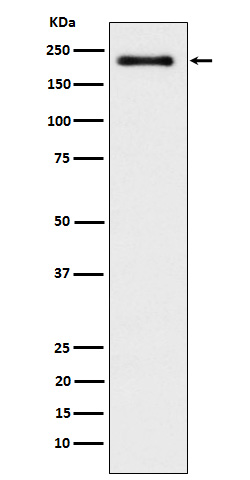Anti-WRN Rabbit Monoclonal Antibody
- SPECIFICATION
- CITATIONS
- PROTOCOLS
- BACKGROUND

Application
| WB |
|---|---|
| Primary Accession | Q14191 |
| Host | Rabbit |
| Isotype | IgG |
| Reactivity | Human |
| Clonality | Monoclonal |
| Format | Liquid |
| Description | Anti-WRN Rabbit Monoclonal Antibody . Tested in WB application. This antibody reacts with Human. |
| Gene ID | 7486 |
|---|---|
| Other Names | Bifunctional 3'-5' exonuclease/ATP-dependent helicase WRN, DNA helicase, RecQ-like type 3, RecQ protein-like 2, Werner syndrome protein, 3'-5' exonuclease, 3.1.-.-, ATP-dependent helicase, 5.6.2.4, DNA 3'-5' helicase WRN, WRN, RECQ3, RECQL2 |
| Calculated MW | 200 kDa |
| Application Details | WB 1:500-1:2000 |
| Contents | Rabbit IgG in phosphate buffered saline, pH 7.4, 150mM NaCl, 0.02% sodium azide and 50% glycerol, 0.4-0.5mg/ml BSA. |
| Clone Names | Clone: 24W80 |
| Immunogen | A synthesized peptide derived from human WRN |
| Purification | Affinity-chromatography |
| Storage | Store at -20°C for one year. For short term storage and frequent use, store at 4°C for up to one month. Avoid repeated freeze-thaw cycles. |
| Name | WRN |
|---|---|
| Synonyms | RECQ3, RECQL2 |
| Function | Multifunctional enzyme that has magnesium and ATP-dependent 3'-5' DNA-helicase activity on partially duplex substrates (PubMed:9224595, PubMed:9288107, PubMed:9611231). Also has 3'->5' exonuclease activity towards double-stranded (ds)DNA with a 5'-overhang (PubMed:11863428). Has no nuclease activity towards single-stranded (ss)DNA or blunt-ended dsDNA (PubMed:11863428). Helicase activity is most efficient with (d)ATP, but (d)CTP will substitute with reduced efficiency; strand displacement is enhanced by single-strand binding- protein (heterotrimeric replication protein A complex, RPA1, RPA2, RPA3) (PubMed:9611231). Binds preferentially to DNA substrates containing alternate secondary structures, such as replication forks and Holliday junctions. May play an important role in the dissociation of joint DNA molecules that can arise as products of homologous recombination, at stalled replication forks or during DNA repair. Alleviates stalling of DNA polymerases at the site of DNA lesions. Plays a role in the formation of DNA replication focal centers; stably associates with foci elements generating binding sites for RP-A (By similarity). Plays a role in double-strand break repair after gamma- irradiation (PubMed:9224595, PubMed:9288107, PubMed:9611231). Unwinds some G-quadruplex DNA (d(CGG)n tracts); unwinding seems to occur in both 5'-3' and 3'-5' direction and requires a short single-stranded tail (PubMed:10212265). d(CGG)n tracts have a propensity to assemble into tetraplex structures; other G-rich substrates from a telomeric or IgG switch sequence are not unwound (PubMed:10212265). Depletion leads to chromosomal breaks and genome instability (PubMed:33199508). |
| Cellular Location | Nucleus, nucleolus. Nucleus. Nucleus, nucleoplasm. Chromosome. Note=Gamma-irradiation leads to its translocation from nucleoli to nucleoplasm and PML regulates the irradiation-induced WRN relocation (PubMed:21639834). Localizes to DNA damage sites (PubMed:27063109). |

Thousands of laboratories across the world have published research that depended on the performance of antibodies from Abcepta to advance their research. Check out links to articles that cite our products in major peer-reviewed journals, organized by research category.
info@abcepta.com, and receive a free "I Love Antibodies" mug.
Provided below are standard protocols that you may find useful for product applications.
If you have used an Abcepta product and would like to share how it has performed, please click on the "Submit Review" button and provide the requested information. Our staff will examine and post your review and contact you if needed.
If you have any additional inquiries please email technical services at tech@abcepta.com.













 Foundational characteristics of cancer include proliferation, angiogenesis, migration, evasion of apoptosis, and cellular immortality. Find key markers for these cellular processes and antibodies to detect them.
Foundational characteristics of cancer include proliferation, angiogenesis, migration, evasion of apoptosis, and cellular immortality. Find key markers for these cellular processes and antibodies to detect them. The SUMOplot™ Analysis Program predicts and scores sumoylation sites in your protein. SUMOylation is a post-translational modification involved in various cellular processes, such as nuclear-cytosolic transport, transcriptional regulation, apoptosis, protein stability, response to stress, and progression through the cell cycle.
The SUMOplot™ Analysis Program predicts and scores sumoylation sites in your protein. SUMOylation is a post-translational modification involved in various cellular processes, such as nuclear-cytosolic transport, transcriptional regulation, apoptosis, protein stability, response to stress, and progression through the cell cycle. The Autophagy Receptor Motif Plotter predicts and scores autophagy receptor binding sites in your protein. Identifying proteins connected to this pathway is critical to understanding the role of autophagy in physiological as well as pathological processes such as development, differentiation, neurodegenerative diseases, stress, infection, and cancer.
The Autophagy Receptor Motif Plotter predicts and scores autophagy receptor binding sites in your protein. Identifying proteins connected to this pathway is critical to understanding the role of autophagy in physiological as well as pathological processes such as development, differentiation, neurodegenerative diseases, stress, infection, and cancer.


